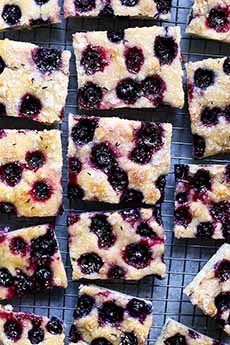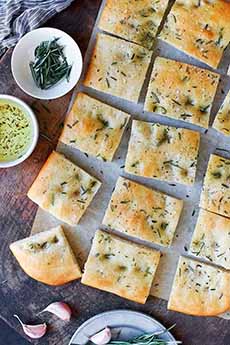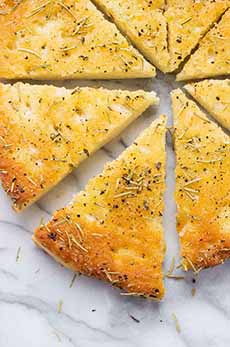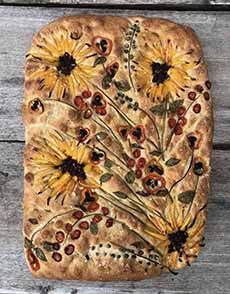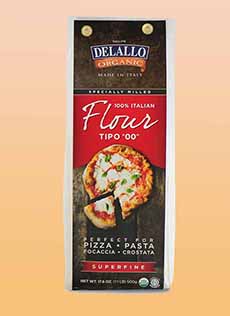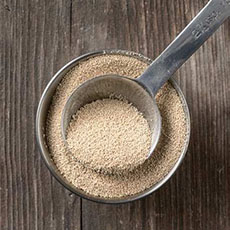RECIPE: Blueberry Focaccia For National Blueberry Month
|
|
Focaccia (foe-KAH-cha) is an Italian yeast bread, baked in a flat or round pan. It is one of the most popular breads in Italy. A bit of history: In the old days before the availability of baking pans, yeast-risen breads and cakes were patted into rounds and baked on hearthstones or griddles. By the 17th century, hoops made of metal or wood were placed on flat pans to shape breads and cakes. In the 17th century, cookware developed so that the European kitchen contained a number of skillets, baking pans, a kettle and several pots, along with a variety of pot hooks to hold the cookware over the fire, and trivets to place the hot cookware when removed from the fire. > The recipe for blueberry focaccia is below. > The history of focaccia is also below. > Also below: the year’s 11 blueberry holidays. > The year’s 20+ bread holidays. > The year’s 35+ berry holidays. > The year’s 58 Italian food holidays. Focaccia is a cousin to pizza. In Italy it is eaten as a snack, but not used as a sandwich bread, as is often done in the U.S. Focaccia—plain or with very light toppings—is some 2000 years older than pizza. The latter has a heavy sauce and robust toppings. Focaccia Vs. Pizza: The Difference Focaccia made with the same ingredients as pizza crust, including finely-ground 00 flour (photo #7), yeast and olive oil. Focaccia should be served warm. To reheat it, use the oven. Don’t microwave it, because as the focaccia cools it will become very hard. You can freeze focaccia, ideally cut into slices; then thaw it on the counter. Reheat it on a baking sheet in a preheated 375°F oven, until it is hot and crispy. While focaccia was a savory bread for thousands of years, cooks have been more recently turning it into a fruit bread or snack, like this recipe. See the photos for links to savory focaccia recipes. Either savory or sweet, enjoy fruit focaccia as a side of bread with soup or salad, with dinner or a fresh cheese or soft cheese (we like it with goat cheese or mascarpone); or as a snack with iced tea or wine. This easy recipe (photo #1), which we share during National Blueberry Month, can be made anytime. Have it for weekend brunch with a side of mascarpone cheese. You can substitute other berries, even cherries. Ingredients For The Dough 1. PLACE the warm water in a large mixer bowl. Sprinkle the yeast on top. Add the olive oil and mix until incorporated. 2. MIX in the salt and 2 cups of the flour on a low speed, until combined. Switch out the flat beater on the mixer for a dough hook, and add the remaining 1-1/2 cups flour. Knead on low speed for 3 minutes, until smooth. 3. TURN the dough out into a large bowl coated with nonstick spray. Cover with plastic and let the dough rise in a warm place until doubled, about 90 minutes. 4. LINE a large rimmed baking sheet or half-sheet pan (18″ x 13″ half-sheet pan) lined with parchment. Brush the parchment with 1 tablespoon of olive oil and scrape the dough out onto the parchment. 5. FLOUR your hands generously and pat out the dough into an even rectangle. Let it rise until puffed, about 45 minutes. Meanwhile, preheat the oven to 400°F. 6. BRUSH the dough with olive oil. Press the top of the dough all over with your fingertips or an implement, to create small dimples. Gently press the blueberries into the dimples and elsewhere in the dough. Sprinkle the dough evenly with the sugar and thyme. Allow it to rest for 15 minutes. 7. BAKE the focaccia for 35 minutes, until golden brown. Let it cool in the pan on a wire rack for at least 15 minutes before serving. Serve topped with turbinado sugar and a drizzle of honey. Focaccia, topped with olive oil and spices, has been around since antiquity. As previously noted, it is some 2,000 years older than its “descendant,” modern pizza [source]. Many historians place it well before the Roman Empire was formed (27 B.C.E.), created either by the Etruscans of what is now North Central Italy, or by the Ancient Greeks. By the second century B.C.E. (also before the Roman Empire), focaccia also was made by the Carthaginians and Phoenicians, with grains such as barley, millet, and rye [source]. The grain may now be wheat, but the basic recipe remains unchanged from those times, relying on wild yeast to rise. Packaged yeast was not introduced until 1878. The original focaccia, like other breads and cakes prior to then, relied on wild yeast in the air. Bakers would puncture the bread with a knife to stop air bubbles from forming on the surface, and “dotted” the bread with their fingers to create wells/dimples that reduce the air in the dough and prevent the bread from rising too quickly. To preserve moisture, olive oil was spread over the dough prior to rising and baking. The name focaccia is derived from the Latin panis focacius, which translates to fireplace bread or center/focus bread. |
|
|
Since the focus of the family home was the fireplace, and all bread was baked in the fireplace, it may have applied to other breads as well. *Type 00 Flour—double zero in English and doppio zero in Italian—is made in Italy with the highest quality wheat, that is specially milled and sifted into an ultra-fine powderlike texture. It is the flour used for pizza crusts and is also used for bread, crostata, desserts, focaccia, and pasta. The flour grading system includes 2, 1, 0 and 00. The lower the number, the more finely ground the flour, and the more bran and germ that have been removed. †Turbinado is raw sugar that retains some light molasses flavor. Sugar In The Raw is a brand of turbinado sugar. Turbinado has slightly finer crystals and is less sticky than demerara sugar, although it is still coarser than conventional white granulated sugar. Muscovado, another raw sugar, has a very moist texture with a strong molasses flavor. See the different types of sugar in our Sugar & Syrup Glossary. ‡Historians believe that breadsticks were first created in 1643 in Piedmont, substantiated by the writing of an abbot who described a long-shaped and “bone-thin” bread being made in a town outside of Turin. Some credit a specific Torinese baker, Antonio Brunero.
CHECK OUT WHAT’S HAPPENING ON OUR HOME PAGE, THENIBBLE.COM. |
||
